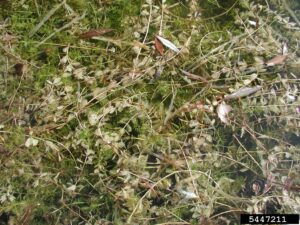
Brazilian Elodea
Rapid growth leads to dense, monospecific mats on the surface of the water. These mats crowd out native

Rapid growth leads to dense, monospecific mats on the surface of the water. These mats crowd out native

Invasive water-primrose species are aquatic plants that can thrive and spread in shallow water areas including wetlands and

The origins of its introduction are unknown, but it is suspected that it was possibly imported as an

Eurasian watermilfoil (Myriophyllum Spicatum) is a plant native to Europe and Asia that was first documented in North

Hydrocharis morsus-ranae, better known as European Frogbit, is an aquatic, invasive species currently spreading throughout the Great Lakes

Flowering rush originated in Eurasia but can now be found throughout the Midwest, including in Southern Michigan, and

Giant Hogweed is a Federally listed noxious weed. Its sap, in combination with moisture and sunlight, can cause

Hydrilla is a stocky whorled submergent plant with spiny leaves in whorls of approximately 4-6. It is well

Two non-native invasive plants that have been gaining a foothold in recent years in Northern Michigan are Japanese

Phragmites (Phragmites australis), also known as the common reed, is an aggressive wetland invader that grows along the

Parrot feather is an aggressive whorled aquatic plant that is similar to watermilfoils, but emergent. Its stems can

Purple loosestrife (Lythrum Salicaria) is an invasive wetland plant that is beautiful, but dangerous. Imported in the 1800s

Rock Snot, also known as didymo, is a non-indigenous nuisance diatom. It can form large mats along the

Starry stonewort is a submerged aquatic macroalgae with many irregular branches. It is native to Europe and was

Water chestnut forms dense mats that shade out native aquatic vegetation, leading to a decrease in biodiversity. Decomposition

Dense mats of vegetation can form to crowd out native species and decrease biodiversity. Water soldier can potentially

Yellow floating heart can create dense mats that shade out native aquatic plants, decrease oxygen levels, increase mosquito
Every dollar invested in Tip of the Mitt Watershed Council helps leverage government and foundation grants for much needed local water quality monitoring and pollution prevention, invasive species management, shoreline restoration, education, and much more.

The Tip of the Mitt Watershed Council is a nonprofit, tax-exempt charitable organization under Section 501(c)(3) of the U.S. Internal Revenue Code. Donations are tax-deductible as allowed by law.
Our employee identification number (EIN) is 38-2361745.
Every effort has been made to ensure the accuracy of information herein; however, it cannot be guaranteed.
Unless otherwise noted, all contents of this website are property of Tip of the Mitt Watershed Council © 2023. All rights reserved.